
(888) 782-8338

Is chronic back pain caused by the manner in which we sit? For many people, this could be the case, according to a growing number of experts in the field of ergonomics. Add to this the fact that we are fast becoming an information processing society, in which increasing numbers of workers transact business while sitting for long periods of time, and we begin to see the crucial role that sitting may play. For modern researchers, many of the ideas proposed two decades ago by Danish surgeon, A.C. Mandal, M.D., regarding the spine began a major paradigm shift in the way we evaluate the seated worker. Many of these ideas have been validated in more recent studies. Simply put, Mandal believed that the century-old concept of proper sitting – upright with a hip angle of 90° – was all wrong. This type of traditional sitting, still practiced today and considered by many to be the one proper way of sitting, is now known to decrease lordosis (the natural or inward curvature) of the lumbar region of the spine, and increase kyphosis (or an outward rounding of this region of the spine). This is exactly the opposite of what we need, in terms of posturally healthy sitting – we should avoid kyphosis in the low back and maintain a moderate level of lordosis. For us, this would mean incorporating the natural curves of the spine into our seated posture, neither flattening nor exaggerating these curves.
When standing erect, the spine assumes a posture of natural lordosis, while kyphosis is difficult to avoid in traditional seated postures. Virtually all experts now consider a proper degree of lordosis in both sitting and standing postures to be critical in maintaining a healthy spine.

Some of the known negative effects of traditional, 90° sitting include:
Mandal emphasized a way of sitting where posture approached the spine’s natural resting position. He called this balanced sitting. A hip angle of 135°, or a forward seat pan tilt of 45°-55° from the horizontal creates the optimum balanced posture for the low back, to the point that a backrest is no longer necessary. Research shows that in this half standing posture, spinal disc pressure is at its lowest.
This seemingly radical concept is not new, however. Going back to as early as 3100 BC, for example, there is evidence that forward tilt (of the seat pan) and, later, reclined forms of seating, were used by both nobility and craftsmen. The purpose appears to have been both for comfort and to enable them to get closer to their work.
Basic options to sitting in this balanced posture might include using:

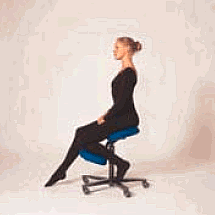

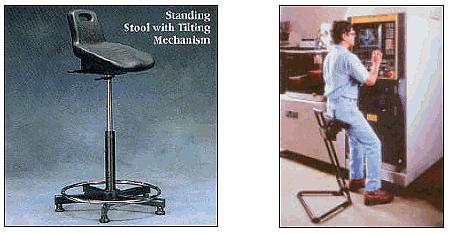
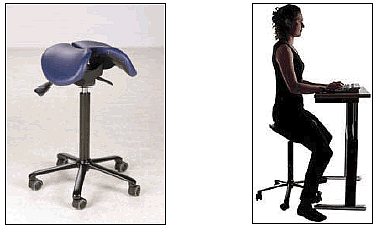
Of these, probably the easiest to adapt to your workplace is the standard chair with the forward seat pan tilt. Unfortunately, only a small percentage of chairs offer this adjustment, and those that do generally don’t tilt far enough to achieve the desired effect. Also, users who do try this technique generally complain that they feel like they are sliding out of their chairs.
The most promising of these options may actually be the saddle chair. Mandal noted that equestrian riders were able to maintain an ideal spinal posture, enhanced by the fact that the saddle required a wide leg stance. There are several types of saddle chairs available, among them a model designed in Finland, called the Salli. Using the Salli model as the example, these backless adjustable chairs offer the recommended forward tilt, the wide equestrian stance, and excellent mobility for the user. The saddle chair appears equally suitable for office/computer-related tasks, light assembly work, the medical field, and customer service jobs. Salli’s manufacturer warns, however, that there are some pre-conditions to its successful usage:
The benefits to this type of chair may include:
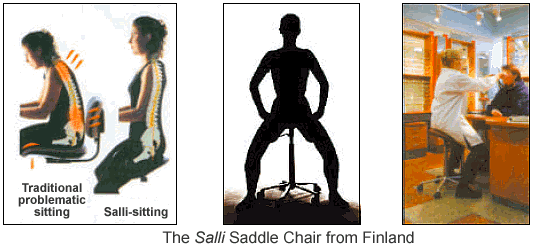
If you stick with your traditional office chair and it does not allow for a forward-tilted posture, there are still some simple things you can do to improve your position:
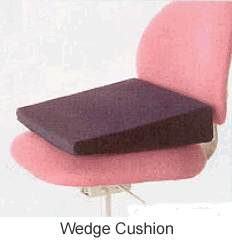
Only time - and future research - will tell if some of these new concepts in seating hold true. But finding a posturally healthy, balanced way of sitting seems to make a lot of sense. The ancient Egyptians learned this, but apparently history forgot. For the sake of our backs, let’s hope that we don’t.
Jeff Tiedeman, an Ergonomics Consultant with State Fund, is a Certified Safety Professional (CSP), a Board-Certified Industrial Ergonomist (CIE) and is certified as an Associate in Risk Management (ARM). He has done extensive research on specialized topics related to ergonomics, including illumination in the workplace, and has written articles and taught classes on these subjects.
Information or recommendations contained in this article were obtained from sources believed to be reliable at the date of publication. This information is only advisory and does not presume to be exhaustive or inclusive of all workplace hazards or situations.